Samsung Galaxy Note 8.0 Review
by Anand Lal Shimpi on April 17, 2013 11:29 PM EST- Posted in
- Tablets
- Samsung
- Android
- Mobile
- Galaxy Note 8.0
The Display
The Note 8.0 holds a slight pixel density advantage over the iPad mini (189 ppi vs. 163 ppi). Just like the earliest Android tablets that held a similar pixel density advantage (~13%), the improvement is noticeable. At the price point and device size however, the Note 8.0 remains under-specced. Just as the iPad mini would benefit from a Retina class display, the Galaxy Note 8.0 could use a 1080p panel as well. Given we're seeing flagship ~5" Android smartphones ship with 1080p displays, a flagship 8" tablet should meet the same criteria.
Unfortunately one of the hallmarks of TouchWiz is that all icons and widgets are considerably larger than they are under iOS, which results in a lot of wasted space on the 8-inch 1280 x 800 display. Despite having a larger display, higher resolution and higher pixel density, I feel more cramped on the Galaxy Note 8.0 than I do on the iPad mini. I understand this is a conscious design decision by Samsung and I can definitely see larger icons, fonts and touch targets resonating very well with certain demographics, but at the same time I believe the design decision flies in the face of what Samsung is hoping to accomplish with the Note family.
The Note 8.0 can get very bright, but black levels suffer as a result. Overall contrast ratio is a bit better than the iPad mini, but I'd prefer better black levels to absurdly high white levels. The latter can help improve readability outdoors, but even cranked all the way up you'll have issues in direct sunlight.
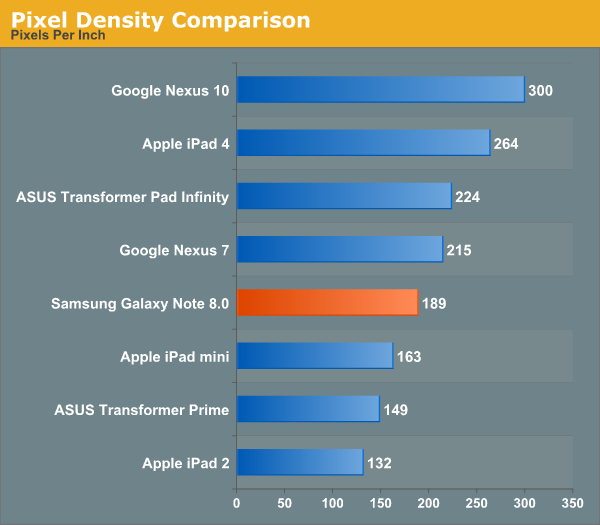
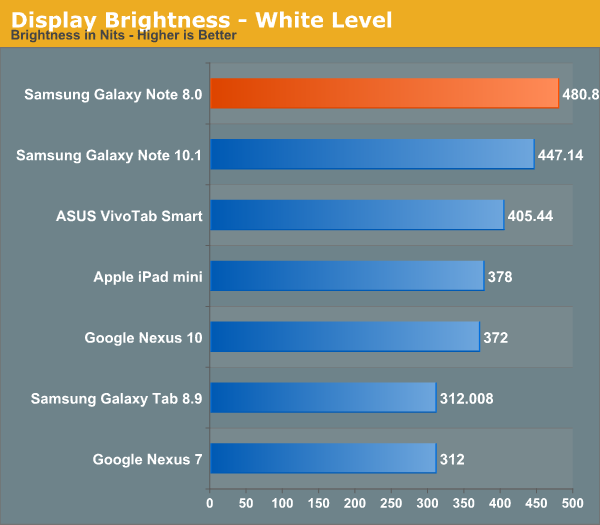
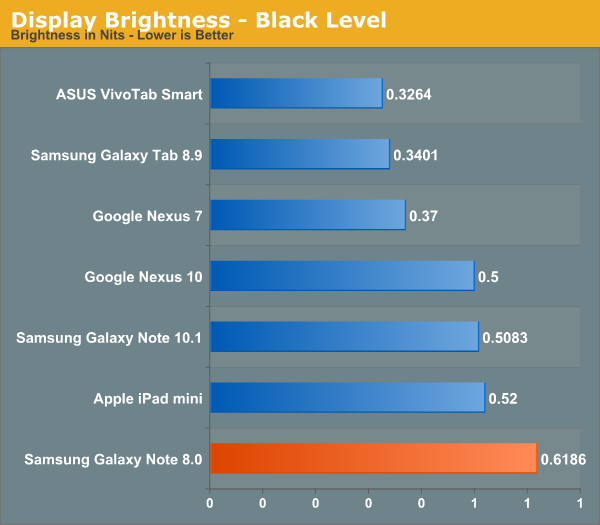
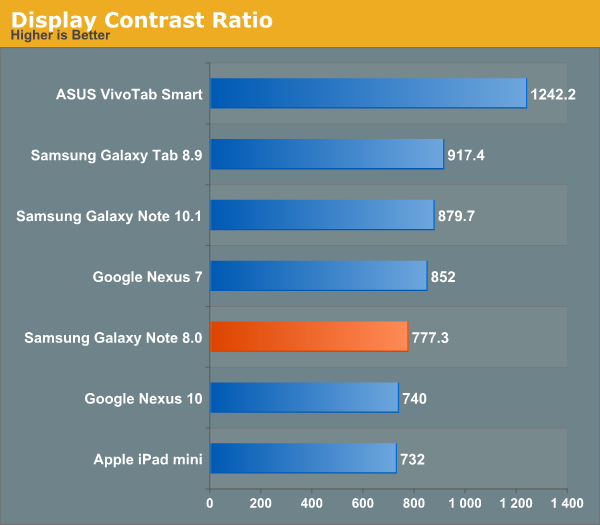
The Galaxy Note 8.0 uses a standard LED backlit LCD display instead of the AMOLED based panels common in Samsung’s smartphones. The departure is a welcome change in my opinion as the Note 8’s avoids Samsung’s AMOLED color calibration tendencies. In fact, the Galaxy Note 8.0’s display performed very similarly to the iPad mini in our color accuracy tests:
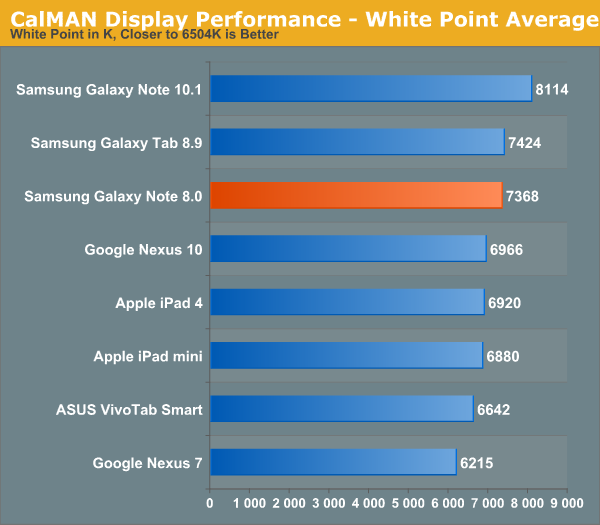
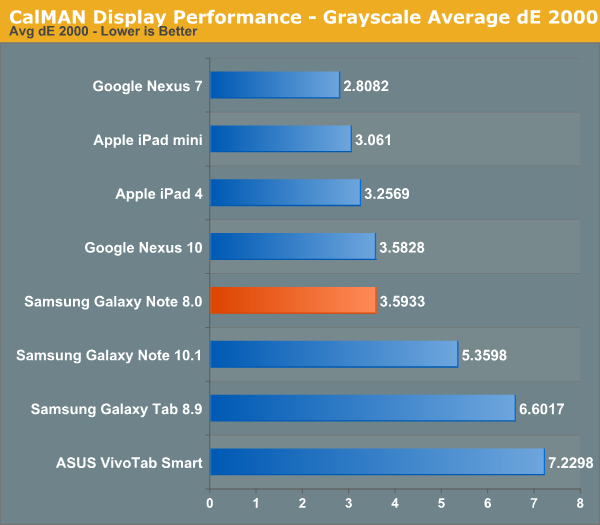

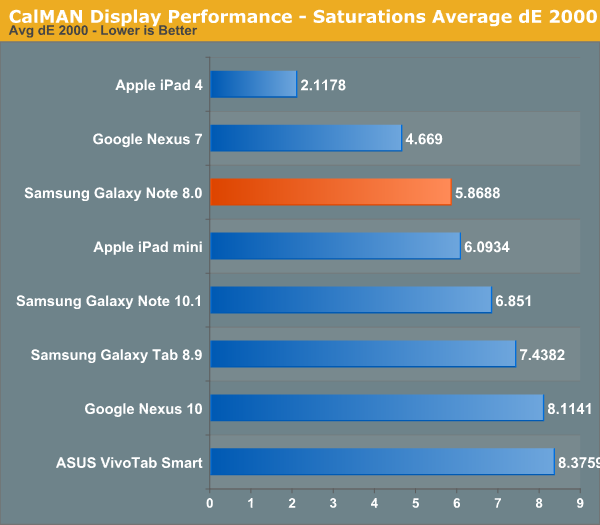

The mini doesn’t feature as accurate of a display as the bigger Retina iPads, which gives the Note 8 a lower target to shoot for, but its performance is admirable nonetheless.
Samsung does offer a couple of display presets on the Note 8, similar to what it does on other platforms. Choosing between Dynamic, Standard and Movie modes plays around with white points and color balance a bit. The standard setting is pretty good out of the box, although movie mode does move the white point closer to 6500K and improved color accuracy by a little bit.
The Note 8’s software build also ships with support for a reader mode that further warms up the white point in an attempt to make reading text easier on your eyes. In an attempt to bring as much of the PC experience as possible to Android tablets, Samsung bombards you with customization options - including the ability to select which applications use reader mode when it’s enabled. You can’t enable reader mode for all apps, but 3rd party apps are supported.


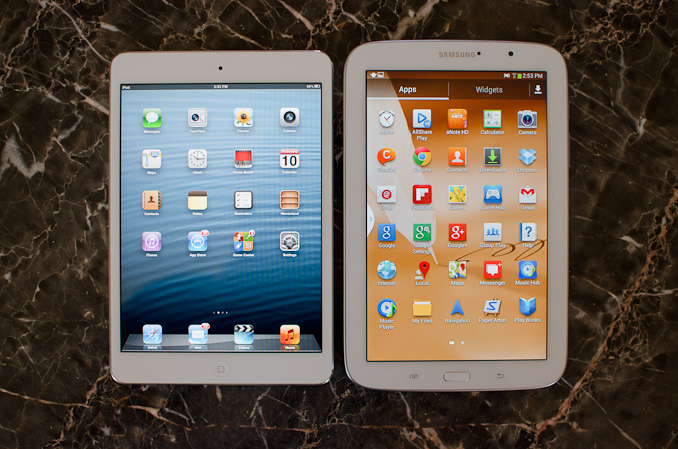











95 Comments
View All Comments
nerd1 - Thursday, April 18, 2013 - link
I think it's better than most people need - it exceeds ipad mini in almost every aspects (except for 10% less battery life) and I think wacom pen + multi-window support is very crucial for many circumstances, like searching for something in one window and writing down a note in the other window.nerd1 - Thursday, April 18, 2013 - link
Also I think it is very absurd that just everyone ignores the micro SD slot when comparing prices. You can get 16GB one and put 32GB or 64GB micro SD to upgrade the storage, and most will do because it is way cheaper, which Nexus or iDevices cannot.steven75 - Thursday, April 18, 2013 - link
It still falls down in one massive area that all Android tablets fall down in: app ecosystem.extide - Thursday, April 18, 2013 - link
Apple fanboy much? lolNekoTipcat - Thursday, April 18, 2013 - link
Ipad mini wins in 2 aspects or 31 Battery
2 GPU
3 iOS (if you like it)
Spunjji - Friday, April 19, 2013 - link
Samsung Note 8.0 wins in 2 aspects or 31 Pen
2 CPU
3 Android (if you like it)
...sorry, I really couldn't resist.
FlyBri - Thursday, April 18, 2013 - link
Anand -- I see you mention that the Galaxy Note 8.0 has a PLS display, but I have seen other information that states the display is a TFT panel. Could you provide some more color on this? Thanks!B3an - Thursday, April 18, 2013 - link
... Err TFT stands for Thin-Film-Transistor. All LCD displays are TFT."TFT LCD" is the general technology and theres many different types of panels for it. PLS is one of them types. The Galaxy Note 8.0 uses PLS which is one of the best kinds of TFT LCD panels.
Sabresiberian - Thursday, April 18, 2013 - link
"PLS" is Samsung's version if LG's "IPS". :)Whether or not it is better - well, there are different versions of both technologies, and Samsung's PLS is newer and so they are still improving it. I would judge on a product-by-product basis.
FlyBri - Thursday, April 18, 2013 - link
My bad, I meant TN, not TFT -- brain fart. In any case, if it's PLS, that's good, but the thing is still overpriced...